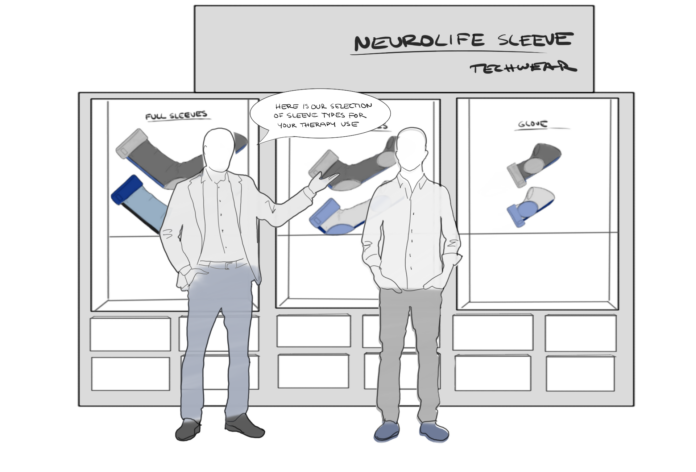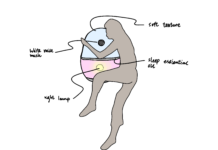From my secondary research analyzing various business models of wearable technology products ranging from Fitbit to glasses and finally to CPAP machines, I drew this conjecture as inspiration from how CPAP machines are prescribed to a patient by a doctor and then bought (similar to how prescription glasses work) at a store.
This conjecture proposes an overarching system of two subsystems that work in conjunction: a storefront for the sleeve and a large array of sleeve peripherals and types.
Sleeve Options
As stroke patients have different conditions and circumstances, the use scenario of the sleeve in rehabilitation varies from person to person, and the sleeve (and its peripherals) should as well. Certain patients may be further along in their rehabilitation and only need the finer controls of their fingers since they have full mobility of their arm. Some patients may need the entire arm. As a result it’s potentially cumbersome for users to be donning an entire sleeve when they really only need the few electrodes near the hand for finer control.
Offering a wide array of sleeves in sizes and forms (full sleeve, partial sleeve, glove, etc.) will help tailor the device for the user as it will be specific for their individual needs in rehabilitation and home use later down the road. In the future, this array of peripherals and sleeves can be offered if the sleeve technology is licensed to multiple medical device companies that can create variations of the same product.
The Storefront
As the sleeve will no longer have one singular or universal form that it needs to take on, a storefront can offer the elevated service of individualizing the device for the user. Similar to how the process of getting a CPAP machine, the prescription from a doctor will enable a stroke patient to visit the sleeve store and talk to a occupational therapist who would then go through the prescription, discuss the pain points of therapy at home, analyze and help the patient with the rehab routine, and finally pick out the best sleeve form and peripherals that best suit their needs.
Patient would then get a sleeve that is most optimal for their lifestyle and will always have a physical place in which they can come in to exchange sleeve types as their rehab evolves or get any help in troubleshooting or maintaining their device.
This system of a storefront allowing for the customization of the sleeve, the ability to upgrade or change the sleeve as therapy evolves, and the support from the staff for technical issues and therapy support gives the patient the best opportunity to get the rehabilitation that’s best for them and improve their means of recovery.
Conjecture Analysis
I like this conjecture as it proposes a simple system that repurposes a similar and already existing one that has similar applications and engages the users in a way that’s very different than how the sleeve was intended to head into market. From this conjecture, the consideration of the following items is important:
The customization or ability to individualize a sleeve for varying intensities of use in a home setting
Providing a venue for technical support and changes to the medical device as necessary for the stage of rehabilitation a user is in.
While I like this system a lot, this contrasts greatly with some secondary and primary research pain points that I’ve discovered in the realm of costs. Health insurance can oftentimes not cover things and directly deters people in engaging with rehab. Additionally, the cost of getting a medical device is high when there is a middle party (retail store) involved. There is issue with this system of CPAP machines already, and there needs to be some work and additional research and consideration for the addition of a storefront to the system that the sleeve operates in.




